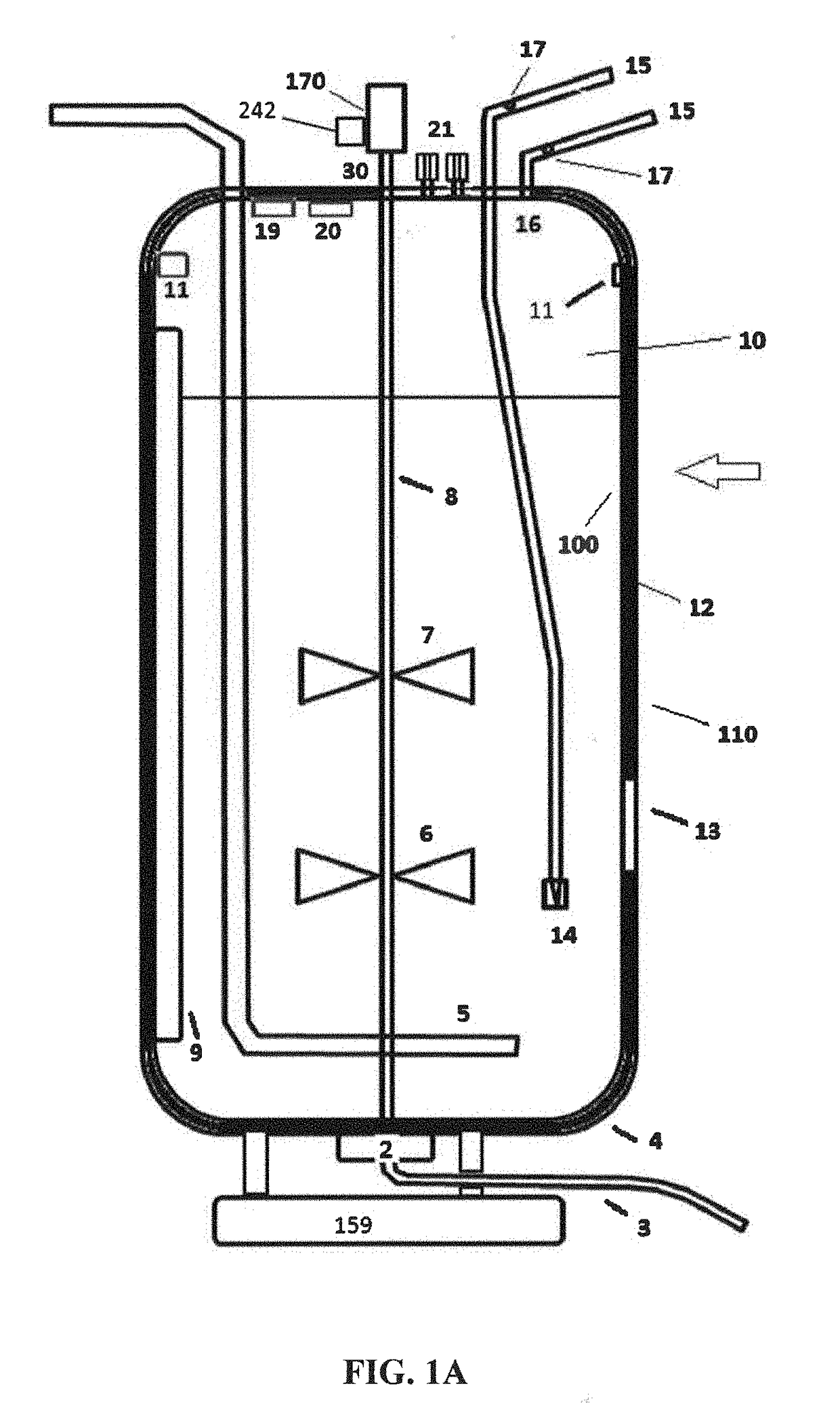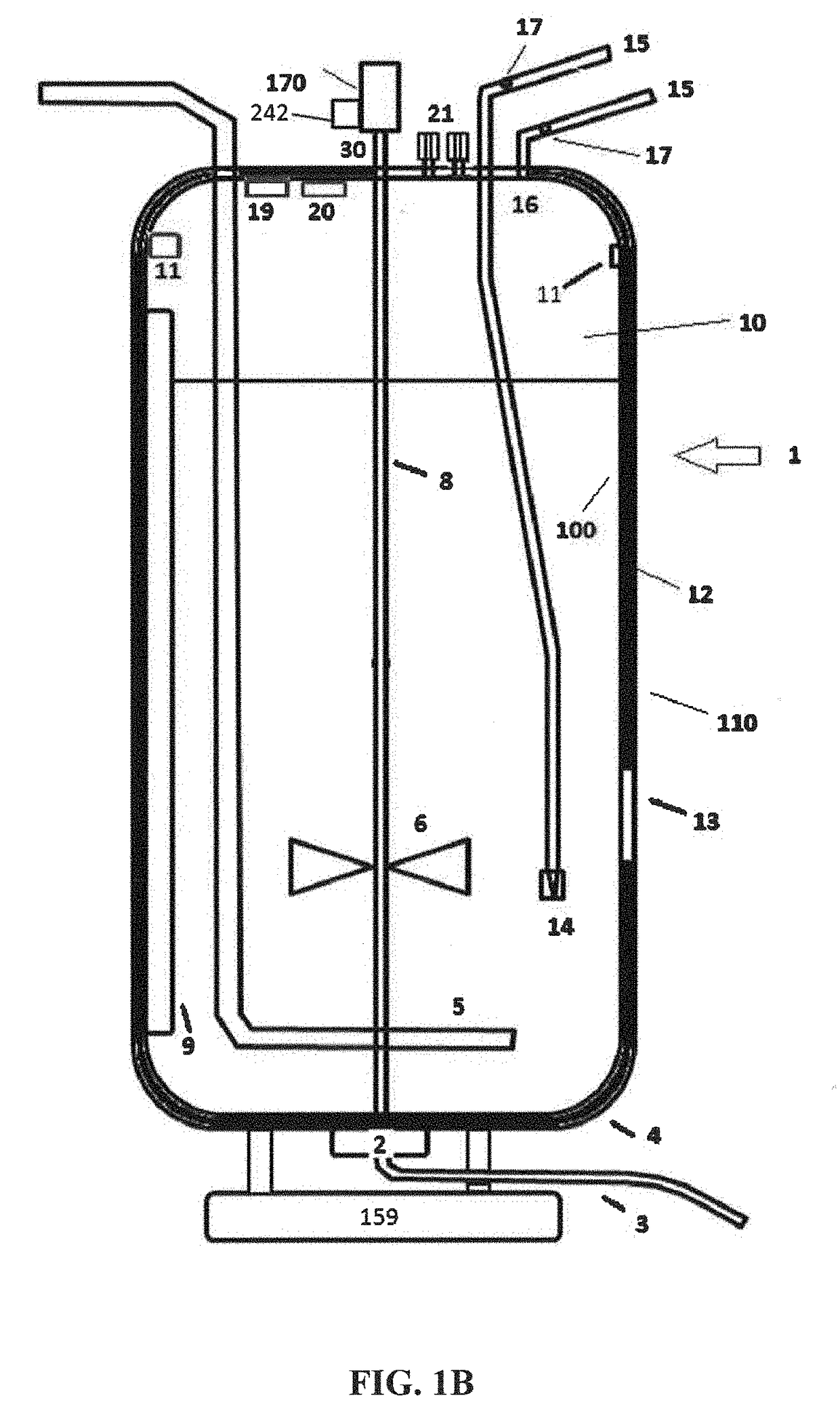These SUBs are supplied by vendors as
off the shelf designs, limiting the
cell culture engineer's ability to match the geometry of the SUB to the geometry of their existing stirred tank reactor (STR) capacity.
The availability of
single use bioreactors designed to facilitate universal use in development, in
manufacturing operations, and in commercialization of biologics through the cultivation of cells, such as eukaryotic (mammalian) cells, is limited by the
state of art.
These limitations stem, in part, from: (i) lack of
scalability to large scale operations up to 20,000 L, such as up to 100,000 L; (ii) lack of
scalability to a small scale (˜10 mL or even ˜1 mL) development model to permit
process development and process characterization in a meaningful manner where the small-scale data produced shows similar and comparable performance to that observed at manufacturing scale; (iii) inadequate mixing and
aeration due to the vessel selection and
agitator design parameters; and (iv) inadequate design of addition ports to permit application of feeds that are bolus, small volume, concentrated and typically non-physiological in pH and osmolality and / or continuously applied feeds or perfusate / retentate at flow rate
ranging from 0.1% v / v per hour to 12.5% v / v per hour.
The current state of the art has additional limitations, such as (i) inadequate design of harvest ports to permit high flow rate without collapsing the harvest tube under the suction head of a pump; (ii) inability to demonstrate process comparability with existing validated bioreactors; (iii) introduction of biologically-
active components from the material of contact; and (iv) the sequestering of biologically
active medium components or
cell-derived metabolites onto the vessel surface, which can result in those components and metabolites becoming limiting or unavailable to the
cell present in the bulk aqueous phase.
The current
state of art for
single use bioreactors is limited to a vessel working volume of from 10 L and up to 2,000 L. The lack of availability of suitable small scale (such as less 10 mL) development models limits the ability of the cell engineer to perform meaningful
process development and process characterization experiments to support manufacturing and commercialization of
cell culture processes.
Meanwhile, the lack of availability of
disposable bioreactors greater than 2,000 L prevents the ability to benefit from the cost of goods reduction that can result from scaling up to beyond 2,000 L.
With regard to bioreactor designs utilizing orbital shaking or rocking, the effectiveness of surface
aeration and mixing is limited by a decrease in the surface area as compared to volume as the scale increases; as such, the use of such design can be limited to bioreactors scaled to less than 500 L. For scales of operation of 2000 L and beyond, the
hydrodynamic forces needed to create energetic ripples that could penetrate the liquid surface and transfer the
mass and energy deep into the liquid bulk would require considerable
mechanical strength in the steel holding vessel, disposable
bioprocess container, motor and the gearing needed to move the
bioprocess container in an orbital motion or tilt it beyond the horizontal plane.
Therefore this mode of mixing is limited to relatively low agitation rates and average energy dissipation rates, which can result in bioreactors that are less well mixed than those stirred bioreactors able to operate at higher agitation rates and P / V.
The low agitation and energy dissipation rates can also limit scale up of such bioreactors.
This uptake requirement can be achieved by employing sintered (microporous spargers) and / or greater sparge rates, which in turn can result in less favorable foaming characteristics due to the vessel operating under a greater
interfacial shear environment.
An alternative approach for mitigating this high
interfacial shear regime is to increase the
oxygen driving force (such as by greatly enriching the blend of
oxygen in the sparge gases); however, this approach is also limited due to the concomitant buildup of metabolic CO2, due to poorer mixing in the vessel, and kLa production that can result with off-center agitated bioreactors.
With the single-mounted off-center
impeller, relatively high and potentially problematic levels of ‘localized’
impeller-zone shear regimes are required to match the average energy dissipation rate, P / V, produced with a dual or multiple impeller agitated bioreactor.
With regard to centrally mounted impellers in unbaffled vessels, the lack of baffles in stirred bioreactors prevent the deflection of radial flow and under higher agitation rates and P / V's risk the formation of a vortex, which can lead to undesirable surface foaming within the bioreactor.
In addition, without baffles within the bioreactor, the full capability of the impeller's power dissipation ability is not realized.
However, such bioreactors also have flat bottoms, resulting in some areas of concerns when compared with baffled cylindrical bioreactors having a curved base plate or bottom.
Due to the perpendicular flat surfaces of the cube bioreactor, the
counter current fluid flow produced by the
agitator and deflection from vessel boundary results in greater occurrence of ‘dead zones’ along the edges and corners.
To prevent occurrence of dead zones in the corners,
hydrodynamic forces can be increased with scale up or greater power dissipation can be applied; however, both of these alternatives can result in greater mechanical fatigue of the seams at edge / corners.
In addition, the
fluid circulation off the bottom of flat bottomed bioreactors is less energetic due to production of counter-current flows from agitator-driven flows and deflection-driven flows from vessel bottom, resulting in less ability to keep cells and / or solids suspended in a flat bottomed bioreactor as compared to bioreactors having base plates designed around the ASME F&D-like geometry.
Additionally, current bioreactors designed to deliver culture aeration through the surface are limited in their ability to be scaled up due to the ever reducing
surface area to volume ratio.
This means that, as such designed vessels are scaled up, the efficiency of and capacity for surface aeration deteriorates.
Sintered spargers can produce fine or small gas bubbles that are more easily dispersed within the vessel bulk; in addition, due to their small size, the
buoyancy forces of the gas bubbles are small, leading to greater
residence time within the liquid bulk and
oxygen mass transfer coefficient, kLa, at any given sparge rate.
However, sintered spargers produce greater interfacial cell shear regimes and less effective metabolic CO2 stripping, both of which are critical aspects in ensuring bio-comparability of
cell culture processes during scale up and during vessel design transfer.
Furthermore, the scale up of sintered spargers is not well understood and can lead to excessively fast linear velocity or pressure from sparge gases emerging from the sparge hole / pore lead to cellular damage.
With regard to inadequate designs of addition ports that permit application of feeds that are non-physiological in nature, such as feeds that have a very high or low pH or a high osmolality and can result upon
exposure to cells in
cell damage and death, current
disposable bioreactors typically rely on addition ports that
discharge onto the culture surface.
While
surface discharge may overcome the complex problem of routing the dip tube within the bioreactor and preventing the inadvertent siphoning of bioreactor content out through the dip tube, such bioreactors can suffer from creation of micro-zones of non-physiological environments at and just below the liquid surface.
Secondly, unimpeded flow of
cell culture can result in the culture not becoming hypoxic or anoxic whilst passing through such tubings and thereby prevent activation of the released cellular factors which can adversely affect the performance process and quality of the product during further
processing.
However, the harvest port and tubing design of all current
disposable bioreactors are inadequate in these respects.
The current lack of
scalability prevents the development of processes that can be consistently applied to the production of cell culture products.
Indeed, the state of the art is such that cell culture
product characteristics are inconsistent across scales, and production processes are for that reason typically modified at different scales to avoid the risk of inconsistent production.
 Login to View More
Login to View More 


